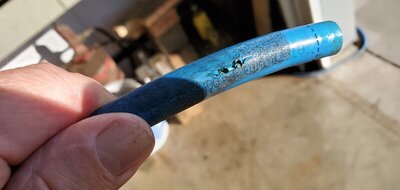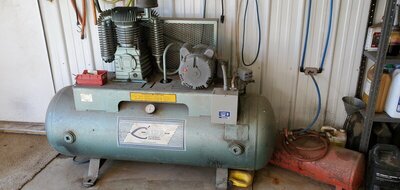rmchrgr
Well-Known Member
After 3 years, I am finally getting my "shop" set up the way I want. Over the last few days, I have been installing the Rapid Air "Maxline" compressed air delivery system. It's been sitting in a box on the floor since 2018 when our house renovation was completed, 'bout time it's being put to use.
Once the garage was done one of my first purchases was a new 80 gallon compressor to replace the ancient 30 gallon Craftsman I've had for decades. You can see it in the foreground here. I bought the air system at the same time in September of 2018.

Since then, I've been using the compressor with a hose connected directly to the outlet valve. It worked fine but sometimes it was a pain if I needed shop air beyond the reach of the hose.
I read up on it a bunch and decided on the RapidAir Maxline system. The kit comes with a bunch of parts to assemble it. I got 100 feet of 1/2" line and not the 3/4" diamter, didn't think I needed a larger diameter. The lines are basically teflon lined Pex. It's a little bit of a PITA to unroll it and get it straight, especially over longer lengths. You cut it to length and then kind of ream it out with a little tool they give you to bevel the edge.
As stated, the kit comes with several accessories to arrange the system. Right off the outlet valve is a water separator filter and pressure regulator. The compressor has a regulator on it but this is for the air line. Once past those two devices, it goes to the wall and connects to a manifold block. Theoretically, there should be a more flexible "whip" hose there but I only had one on hand and it's attached to my hose reel. I very well may change out that existing blue line for a flex hose, the compressor shakes pretty good when it first starts.
Anyway, the horizontal manifold block provides two branch outlets so the lines can go in different directions. So far I've only got the one side done. The other leg will go left towards the work bench on the back wall.

This is about 30-35 feet of line.

Got a hose reel installed on the lift. It needs to be up higher the hose is hanging right in my face. It's only held on by two bolts at the moment. There are four holes in the reel bracket so using the top ones will move up about 6" which will be about perfect.

The hose reel connects to the main line from a T fitting.

This is by the front. I wanted an outlet by the door for airing up tires, blowing things off outside, etc.

The lines are attached to the wall with these plastic standoffs. They come with #8 nails in them but they were too short to fully engage the studs in the wall. I substituted the nails for some longer #8 screws which worked well.

The kit comes with these type of fittings. You get several straight ones, elbows and one tee.

The line is secured with the serrated ferrule thing.

The ends of the individual legs terminate with these distribution blocks. There are three of these blocks included in the kit along with the 45º fitting, drain petcock and threaded plugs for unused outlets. I am using quick disconnects here, no need for a hose reel in either spot, they'd be in the way. I have two extra hoses that I can grab and snap it in when needed.

Once I got going on it, the kit installed pretty easily. If you have it all laid out and have everything you need on hand, you could easily do it in a couple hours. The plastic standoffs are not included in the kit but you can get them or something similar at any hardware store or orange/blue big box home place.
There are a few drawbacks. The manifold blocks are flat and wider than a wall stud which can make it a chore to attach to the wall - in my opinion you need to have some sort of standoff bracket which an be tedious to come up with and drill out. And again, as with any type of coiled tubing, it sucks to straighten it out over long lengths. It turned out OK but I hate the appearance of the little waves between the standoffs. Is what it is I guess. I know there is a tubing straightener available but for a one-time install it's probably not worthwhile to spend the money on it.
Will update this thread when I get it all buttoned up. Hope this helps anyone considering this system for their own shop.
- Greg
Once the garage was done one of my first purchases was a new 80 gallon compressor to replace the ancient 30 gallon Craftsman I've had for decades. You can see it in the foreground here. I bought the air system at the same time in September of 2018.
Since then, I've been using the compressor with a hose connected directly to the outlet valve. It worked fine but sometimes it was a pain if I needed shop air beyond the reach of the hose.
I read up on it a bunch and decided on the RapidAir Maxline system. The kit comes with a bunch of parts to assemble it. I got 100 feet of 1/2" line and not the 3/4" diamter, didn't think I needed a larger diameter. The lines are basically teflon lined Pex. It's a little bit of a PITA to unroll it and get it straight, especially over longer lengths. You cut it to length and then kind of ream it out with a little tool they give you to bevel the edge.
As stated, the kit comes with several accessories to arrange the system. Right off the outlet valve is a water separator filter and pressure regulator. The compressor has a regulator on it but this is for the air line. Once past those two devices, it goes to the wall and connects to a manifold block. Theoretically, there should be a more flexible "whip" hose there but I only had one on hand and it's attached to my hose reel. I very well may change out that existing blue line for a flex hose, the compressor shakes pretty good when it first starts.
Anyway, the horizontal manifold block provides two branch outlets so the lines can go in different directions. So far I've only got the one side done. The other leg will go left towards the work bench on the back wall.
This is about 30-35 feet of line.
Got a hose reel installed on the lift. It needs to be up higher the hose is hanging right in my face. It's only held on by two bolts at the moment. There are four holes in the reel bracket so using the top ones will move up about 6" which will be about perfect.
The hose reel connects to the main line from a T fitting.
This is by the front. I wanted an outlet by the door for airing up tires, blowing things off outside, etc.
The lines are attached to the wall with these plastic standoffs. They come with #8 nails in them but they were too short to fully engage the studs in the wall. I substituted the nails for some longer #8 screws which worked well.
The kit comes with these type of fittings. You get several straight ones, elbows and one tee.
The line is secured with the serrated ferrule thing.
The ends of the individual legs terminate with these distribution blocks. There are three of these blocks included in the kit along with the 45º fitting, drain petcock and threaded plugs for unused outlets. I am using quick disconnects here, no need for a hose reel in either spot, they'd be in the way. I have two extra hoses that I can grab and snap it in when needed.
Once I got going on it, the kit installed pretty easily. If you have it all laid out and have everything you need on hand, you could easily do it in a couple hours. The plastic standoffs are not included in the kit but you can get them or something similar at any hardware store or orange/blue big box home place.
There are a few drawbacks. The manifold blocks are flat and wider than a wall stud which can make it a chore to attach to the wall - in my opinion you need to have some sort of standoff bracket which an be tedious to come up with and drill out. And again, as with any type of coiled tubing, it sucks to straighten it out over long lengths. It turned out OK but I hate the appearance of the little waves between the standoffs. Is what it is I guess. I know there is a tubing straightener available but for a one-time install it's probably not worthwhile to spend the money on it.
Will update this thread when I get it all buttoned up. Hope this helps anyone considering this system for their own shop.
- Greg


















